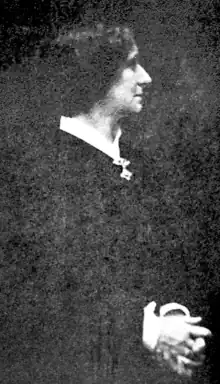Helen Morton (physician)
Helen Morton (September 27, 1834 – March 22, 1916) was an American obstetrician, one of the early generation of women physicians practicing in Boston in the nineteenth century.
Helen Morton | |
|---|---|
 Helen Morton, from a 1918 publication | |
| Born | September 27, 1834 Plymouth, Massachusetts |
| Died | March 22, 1916 (age 81) Boston, Massachusetts |
| Occupation | Physician |
Early life and education
Morton was born in Plymouth, Massachusetts, the daughter of Edwin Morton and Betsy Torrey Harlow Morton. Both of her parents were also born in Plymouth. She was descended from Puritan leader George Morton, and through that connection was related to many prominent New Englanders. She attended Antioch College and the Woman's Medical College of Pennsylvania, then completed her medical degree at the New England Female Medical College in 1862. She had further training in obstetrics in Paris.[1][2]
Career
Morton spent two years as director of an obstetric hospital in Paris in the 1860s. She was awarded a medal by the French government in 1864.[1] She returned to Boston and was an attending physician at the New England Hospital for Women and Children,[3][4] in charge of maternity services, for at least twenty years.[5] She was close colleagues with Maria Zakrzewska, Ednah D. Cheney, Susan Dimock, and Lucy E. Sewall, among other women physicians working in Boston in her time.[6][7][8]
Morton was a member of the American Forestry Association,[9] and a supporter of the Boston Music School Settlement.[10] She donated several subscriptions of periodicals, including American Journal of Archaeology and Forestry and Irrigation, to the Plymouth Public Library.[11] She was also active in the Boston Young Women's Christian Association,[12] and a subscribing member of the Women's Educational and Industrial Union.[13]
Personal life and legacy
In the 1890s, Morton lived with another obstetrician, Mary Forrester Hobart, in Boston.[14][15] Hobart was the great-great-granddaughter of Maine midwife and diarist Martha Ballard.[16] Morton had severe arthritis that kept her from working in her later years.[1][5] In 1906, the Helen Morton Wing of Sewall Maternity Hospital was named in her honor.[5][6] She died in 1915, at the age of 81, in Boston. In her memory, her family donated an ambulance to the American Women's Hospitals Service in France during World War I.[1]
References
- "Dr. Helen Morton" Woman's Medical Journal 28(11)(November 1918): 238-239.
- Stanton, Elizabeth Cady; Anthony, Susan Brownell; Gage, Matilda Joslyn (1886). History of Woman Suffrage. Susan B. Anthony. p. 299.
- "Charity Where Woman Reigns". The Boston Globe. 1900-12-17. p. 7. Retrieved 2023-04-03 – via Newspapers.com.
- "Work of the N. E. Hospital; Interesting Reports Made at the Annual Meeting". The Boston Globe. 1893-11-01. p. 2. Retrieved 2023-04-03 – via Newspapers.com.
- New England Hospital for Women and Children (1913). The Fiftieth anniversary of the New England Hospital for Women and Children, Dimock Street, Boston, Mass. October twenty-nine, nineteen hundred twelve. Geo. H. Ellis Company. pp. 21, 28, 47–48.
- Vietor, Agnes C. (1924). "A Woman's Quest - The Life of Marie E. Zakrzewska, M.D." Project Gutenberg. pp. 352, 440. Retrieved 2023-04-03.
- New England Hospital for Women and Children (1896). Annual Report. p. 4.
- Drachman, Virginia G. (1984). Hospital with a heart : women doctors and the paradox of separatism at the New England Hospital, 1862-1969. Ithaca: Cornell University Press. ISBN 0-8014-1624-8. OCLC 10432289.
- American Forestry Association (1897). Proceedings of the American Forestry Congress. p. 11.
- Music schools in Boston: Pamphlet box]. 1914. p. 31.
- Town), Plymouth (Mass (1905). Annual Report. p. 79.
- Boston Young Women's Christian Association (Massachusetts) (1891). Annual Report of the Boston Young Women's Christian Association. The Association.
- Women's Educational and Industrial Union (Boston Mass.) (1914). Report of the Women's Educational and Industrial Union. p. 66.
- "320 Marlborough". Back Bay Houses. 2013-08-03. Retrieved 2023-04-03.
- Hobart, Mary Forrester (1911-06-22). "Indications for Cæsarean Section". The Boston Medical and Surgical Journal. 164 (25): 885–886. doi:10.1056/NEJM191106221642505. ISSN 0096-6762.
- "A Midwife's Tale: Epilogue". DoHistory. Retrieved 2023-04-03.